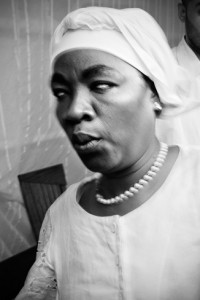In class, we briefly touched on the beginnings of spiritualist photography. The contemporary photographer Shannon Taggart has photographed the world’s largest Spiritualist community in western New York. Her photographic projects seem to focus on alternative types of religious experience. Taggart’s recent work is based on the Haitian practice of Vodou right here in Brooklyn. Read about and look at some of her photographs at the Time Magazine Lightbox website: http://tinyurl.com/8hzgg73.
You can further explore Taggart’s Vodou series and her other photographs on her personal website: www.shannontaggart.com.
We’ve discussed the difficulty of producing religious imagery via photography (remember F. Holland Day?). For this post, I would like you to consider the difficulties of documenting religious experience. Do you think such documentation possible? valuable? intrusive?
Please share with your ideas by Saturday, October 27th.





Since we live in a world where people from different regions practice different beliefs and religions, it’s kind of necessary to have people who are eligible to document their practices via pictures/videos. Taggart is a good example for this topic. She takes pictures from different practices. To be honest, as a person who watches these practices from the outside of their faith, I was quiet terrified to look at them, because to me, the whole communicating-with-the-dead practice is scary yet amusing and being able to see what they have to go through in order to free the spirit/demon from their soul and body, made my body tremble. But, unfortunately, we have biased photographers out there, who try to change the whole concept and beliefs of a religion based on their own opinions and present it to the whole world. This is a very sad topic to deal with, because majority of people believe what they see… So, to realize if these photographs and documentations are valuable and effective, we have to see and understand the view of the photographer itself. (To me, “some” of them are effective, because I can feel the common view between myself and the photographer, but for example, most of the pictures regarding my religion look too fake and unacceptable)
In this world it is difficult to document such pratices and blief thoe people do underground. We have in brooklyn, a lot of people do vodou. As a haitian guy, it is true. In Hati, they perform a lot of those and its different part of the country. Taggart documentary on vodou, take a lot of resource to find this type of belief and the things those people do. people do usually take pictures of such thing like vodou. This is the first time of seing those kinda pictures. Those picture sen valuable becuse, it let the world know what’s going on around them and what kind of activiy that are being performed underground. The pictures look evil and you could see the effect it have on the people thar are being possece by the vodou.
i feel that documenting this is a major challenge for for shannon taggart because being that this is new york city a lot of people really enjoy their privacy. so for them to allow her to not only attend these private ceremonies but to also photograph them is insane to me. i feel like her documentation is more about capturing the emotion that the people who participate in these rituals actually go through. i don’t think shes capturing any ghosts or spirits in her photographs.
I was born and raised in Nepal, as i grew up – i have seen, heard many stories which were affiliated with spirits and vodou. My baby sitter was once affected by spirits and she ended up eating an entire stack of burning incense in front of our eyes. she was living with us since about 7-8 months and she was as normal as any of us but that day was a total shock. Beyond our own houses people practice Vodou at many levels and exploring and showcasing them through photography has been one of my future approaches. I feel expressions like this will be educative at the same time when presented with abstraction can result artistic.